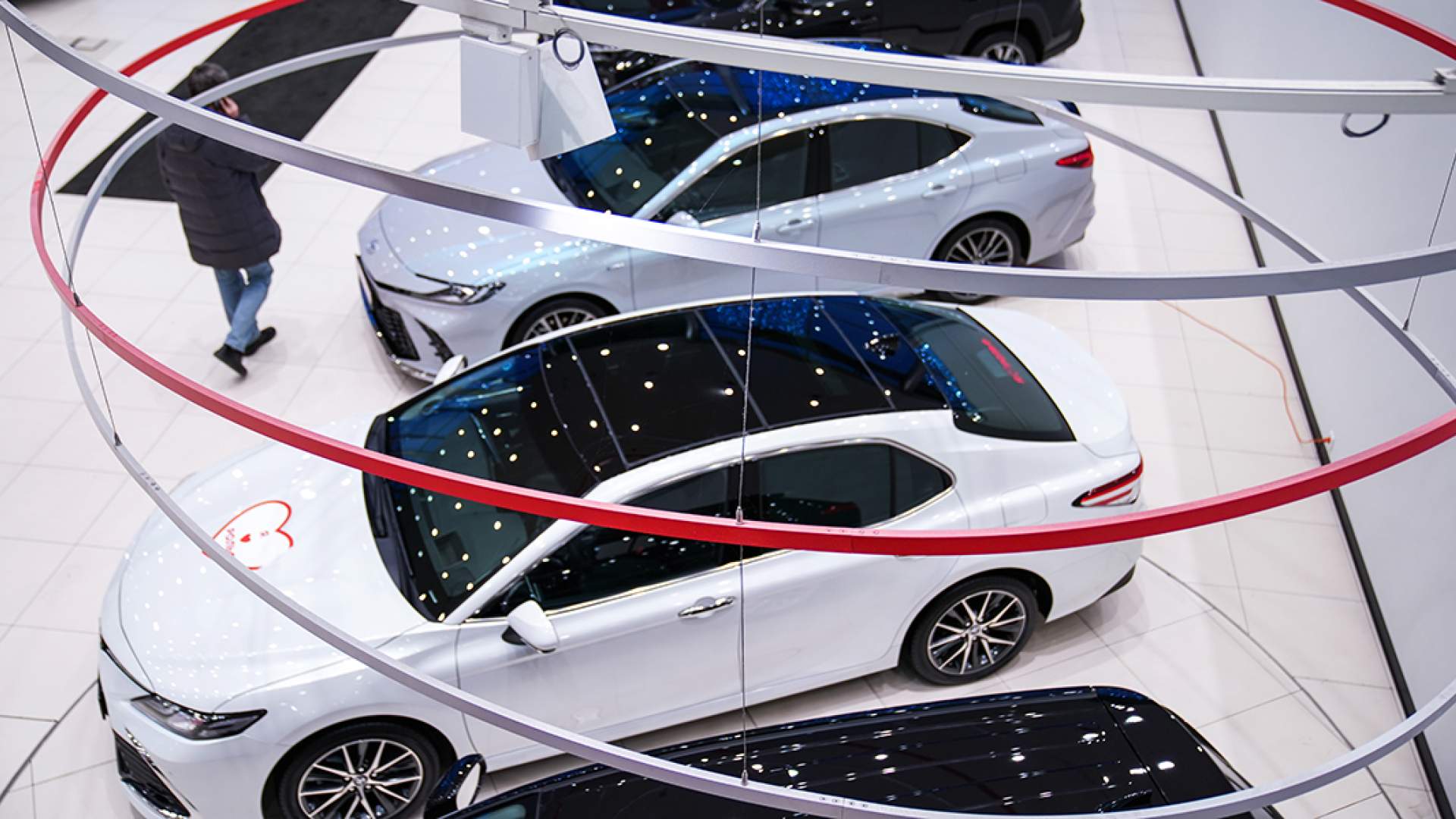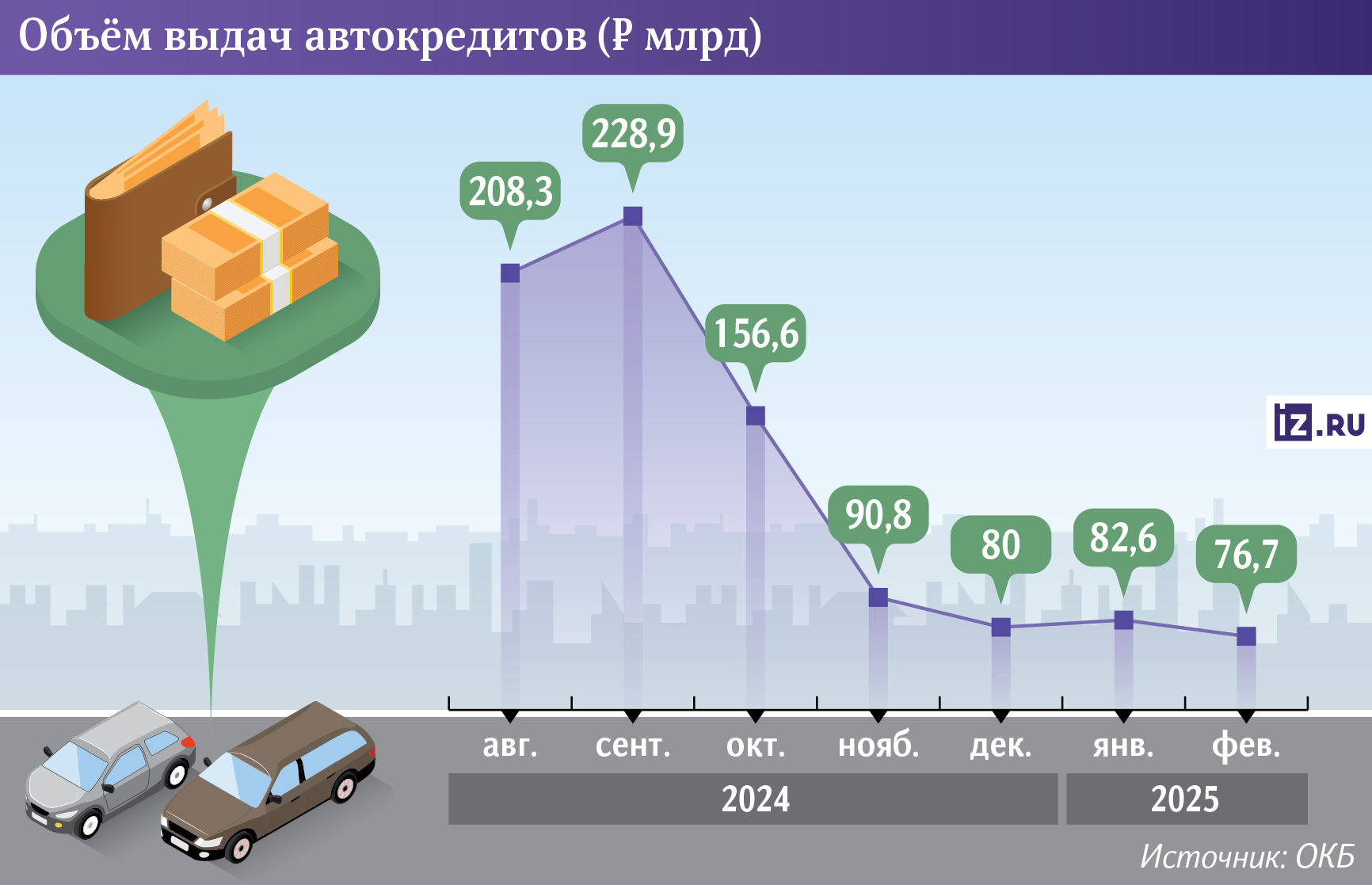They've gone downhill: car loan disbursements have collapsed to two-year lows

The issuance of car loans in February reached record lows of almost 77 billion rubles, which is the minimum for the last two years, according to the OKB (Izvestia has it). The market is facing a drop in demand due to stricter regulation by the Central Bank and federal authorities. To support sales, dealers are ready to accept discounts that already reach 100-300 thousand rubles. Nevertheless, prices will inevitably rise by the end of the year: imported cars will become more expensive due to high recycling, and our automotive industry does not have enough capacity to fully cover the demand from Russians. What will happen to this market in 2025 is in the Izvestia article.
Conditions for issuing car loans
In February, banks issued 62.3 thousand car loans to Russians for 76.7 billion rubles, which is the minimum since the spring of 2023, the United Credit Bureau (OKB) told Izvestia. Compared to the same period last year, the issuance decreased by one and a half times, the Scoring Bureau confirmed.
Banks are also talking about a strong reduction in disbursements compared to the previous year. In VTB, they fell by half, in OTP Bank — by three times, in Sovcombank — by one and a half times, the press services of the organizations reported.
At the same time, the average check for car loans is also decreasing — in February it amounted to 1.2 million rubles, which is 15% less than in the same period last year, according to OKB data. At the same time, the total cost of car loans has been decreasing for four months in a row, its average reached 23.5%. The cost includes the interest rate per annum and all additional loan costs (insurance and possible fees).
The average term of car loans is also at minimum levels: five years and four months. The overpayment on a car loan with such conditions can amount to about 800 thousand rubles, which is 70% of the initial cost of the car, Izvestia estimated.
Russian and Chinese brands are in high demand among customers in the new car market, said a representative of Absolut Bank. About 40% of sales come from Lada, another 14% from Chinese Chery, and 9% from Changan. There is also a high demand for other brands from China, such as Haval and Kaiyi.
Why has the demand for cars plummeted
Banks issue fewer car loans, as the Central Bank consistently pursues a policy of "cooling" this market, said Oleg Lagutkin, CEO of the Scoring Bureau. In mid-2024, the regulator imposed restrictions on financial institutions to issue car loans to borrowers who spend more than 50% of their income on debt servicing. This measure has led to a tightening of banks' risk policies and significantly narrowed the number of potential customers.
However, the main reason for the collapse of the car loan market can rightfully be considered an increase in the recycling fee. It is paid by the sellers, but all costs are included in the cost of the car.
The recycling fee is paid by importers and manufacturers for each car sold in the Russian Federation. But this amount is returned to domestic companies in the form of subsidies. Therefore, the growth of recycling mainly affects foreign cars. Since October 1, 2024, the indicator has increased by 70-85% at once, depending on the parameters of the car, for example, engine volume. Since January 1, 2025, it has been increased again, this time by an average of 10%. Scrap collection for cars with an engine capacity of up to 2 liters can reach 500 thousand — this is a significant percentage of the purchase price.
Back in March 2024, both banks and borrowers realized that the time available for cars would soon end, which is why loans for their purchase jumped to record levels, recalled Alexey Volkov, Marketing Director of the National Bureau of Credit Histories (NBKI). However, in October, when the new requirements for the import of foreign cars into the Russian Federation began to work, sales began to fall rapidly — the trend continues to this day.
The introduction of recycling is aimed at supporting the domestic automotive industry, and is also intended to encourage foreign brands to move production to Russia, explained economist Andrey Barkhota. However, Chinese manufacturers are in no hurry to do this.
In addition, prices for cars before October 2024 were already rising against the background of high demand before the growth of recycling, added Vladimir Chernov, analyst at Freedom Finance Global. And also because of the weakening of the ruble at the end of that year. Over the past six months, the cost of passenger cars has increased by an average of 7-12%.
According to the plan approved by the Government of the Russian Federation, the recycling fee for cars will increase annually by 10-20% until 2030, concluded Vladimir Chernov. This continues to drive up prices.
How to get a discount on a car
Dealers are the ones who suffer the most from the drop in demand for cars, said economist Andrei Barkhota. The fact is that up to 40% of the car fleet for sale can be purchased on credit. To pay off their debts, it is important for them to sell the product, so they can introduce discounts.
— If dealers buy cars right away, they are cheaper than the market value anyway. This difference can be turned into a discount by sacrificing part of the income for the sake of sales promotion," explained Andrey Barkhota.
The discount varies depending on the brand and model, reaching several million rubles in some cases, said Vladimir Chernov, analyst at Freedom Finance Global. In March, the average discount in Russian car dealerships increased to 100-300 thousand rubles.
— Additional discounts are available on Belgee, Geely and Haval vehicles. In recent weeks, the cost of cars from at least nine brands has decreased significantly," the expert added.
It turns out that buying a car in conditions of low demand in the market can be profitable, Andrey Barkhota summed up.
Nevertheless, in 2025, car prices will continue to rise, stated Vladimir Chernov. This is inevitable against the background of increased recycling and a limited supply of cars in Russia. Their cost will increase by at least 10-15% by the end of the year, but more dramatic dynamics is possible for individual models.
The return of foreign brands to the Russian market could save the situation with the supply of cars, the demand for them, and the cost, Freedom Finance Global added. For example, there are rumors that the Japanese Toyota brand is considering this possibility. Nevertheless, even if the supply of cars to the Russian Federation increases significantly, their cost will continue to increase from year to year along with the recycling fee, because this measure is aimed specifically against imports.
Переведено сервисом «Яндекс Переводчик»







